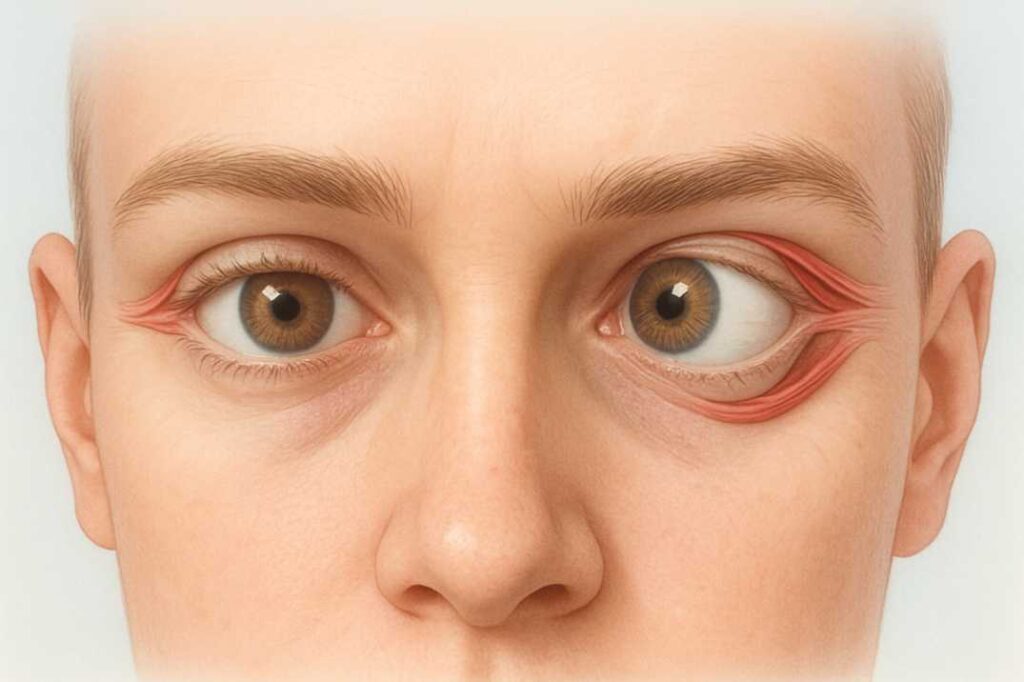Strabismus
What Is Strabismus? Understanding the Basics
Strabismus, commonly called “crossed eyes,” “wandering eye,” or “squint,” is a condition where the eyes don’t align properly when focusing on an object. Instead of both eyes working together to look at the same target, one eye may turn inward (esotropia), outward (exotropia), upward (hypertropia), or downward (hypotropia).
This misalignment isn’t just about appearance—it’s a functional vision disorder that can significantly impact depth perception, reading ability, and quality of life. When your eyes don’t work together properly, your brain may begin to ignore signals from one eye, potentially leading to permanent vision loss in that eye, a condition called amblyopia or “lazy eye.”
How Normal Eye Alignment Works
Each eye is controlled by six muscles that work together like a perfectly choreographed team. These muscles receive signals from your brain that coordinate their movements, ensuring both eyes focus on the same object simultaneously. When this system functions properly, your brain combines the slightly different images from each eye into a single, three-dimensional view of the world.
In strabismus, this coordination breaks down. One or more of the eye muscles may be too weak, too strong, or not receive proper nerve signals, causing the eyes to point in different directions.
Types of Strabismus: Understanding Your Specific Condition
Horizontal Strabismus
Esotropia (Inward Turning)
- Infantile Esotropia: Develops within the first 6 months of life, often requiring early surgical intervention
- Accommodative Esotropia: Usually emerges between ages 2-5, often related to farsightedness, and may improve with glasses
- Acute Esotropia: Sudden onset, more common in adults, and may indicate underlying neurological issues
Exotropia (Outward Turning)
- Intermittent Exotropia: Eyes drift outward occasionally, especially when tired or focusing on distant objects
- Constant Exotropia: Persistent outward turning that may worsen without treatment
Vertical Strabismus
Hypertropia/Hypotropia
- One eye turns up (hypertropia) or down (hypotropia) compared to the other
- Often more complex to treat and may involve multiple eye muscles
Paralytic vs. Non-Paralytic Strabismus
Paralytic Strabismus
- Caused by weakness or paralysis of one or more eye muscles
- Often results from nerve damage, stroke, or injury
- May cause double vision and head tilting
Non-Paralytic (Comitant) Strabismus
- The angle of misalignment remains the same regardless of which direction you look.
- The most common type in children
- Usually not associated with muscle paralysis
Recognizing Strabismus: Signs and Symptoms
In Children
Early detection is crucial for preventing long-term vision problems. Watch for these warning signs:
Obvious Visual Signs
- Eyes that don’t move together when following objects
- One eye turning in, out, up, or down
- Eyes that appear crossed in photographs
- Squinting or closing one eye frequently
Behavioral Indicators
- Tilting or turning the head to see better
- Covering one eye with their hand
- Bumping into objects on one side
- Difficulty with activities requiring depth perception (catching balls, pouring liquids)
Learning and Development Concerns
- Reading difficulties or complaints about words “jumping around”
- Avoiding close-up activities like drawing or puzzles
- Poor hand-eye coordination
- Fatigue during visual tasks
In Adults
Adult-onset strabismus often causes different symptoms than childhood strabismus:
Visual Symptoms
- Double vision (diplopia)—seeing two images of a single object
- Eye strain and headaches, especially after reading or computer work
- Difficulty judging distances
- Problems with night driving
Compensatory Behaviors
- Closing or covering one eye to eliminate double vision
- Turning the head to use peripheral vision
- Using unusual head positions to align the eyes
Psychosocial Impact
- Self-consciousness about appearance
- Difficulty making eye contact
- Avoiding social situations or photographs
- Impact on professional opportunities
What Causes Strabismus? Understanding the Risk Factors
Childhood Causes
Genetic Factors
- Family history significantly increases risk—if a parent has strabismus, children have a 5-15% chance of developing it.
- Certain genetic syndromes are associated with higher strabismus rates
Refractive Errors
- Significant farsightedness (hyperopia) can trigger accommodative esotropia
- Large differences in prescriptions between eyes
- Astigmatism in some cases
Medical Conditions
- Cerebral palsy increases risk by 15-20%
- Down syndrome is associated with strabismus in 20-60% of cases
- Premature birth and low birth weight
- Hydrocephalus and brain tumors
Adult-Onset Causes
Neurological Conditions
- A stroke affecting the brain areas controlling eye movement
- Multiple sclerosis and myasthenia gravis
- Brain tumors or aneurysms
- Thyroid eye disease (Graves’ ophthalmopathy)
Trauma and Injury
- Head injuries affecting the nerves controlling the eye muscles
- Direct trauma to the eye or eye socket
- Complications from other eye surgeries
Age-Related Changes
- Weakening of eye muscles over time
- Changes in the tissues supporting the eyes
- Development of other medical conditions affecting vision
The Importance of Early Diagnosis and Treatment
Critical Development Periods
The visual system undergoes crucial development during the first 8-11 years of life. During this period, the brain learns to process and coordinate visual information from both eyes. If strabismus goes untreated during these critical years, several problems can develop:
Amblyopia Development
- The brain begins ignoring the misaligned eye to avoid confusion
- Once established, amblyopia becomes increasingly difficult to reverse
- It can result in permanent vision loss in the affected eye
Loss of Binocular Vision
- Inability to use both eyes together effectively
- Poor depth perception affects safety and performance
- Difficulty with tasks requiring precise hand-eye coordination
Stereopsis Loss
- Reduced ability to see in three dimensions
- Impacts sports performance, driving safety, and certain career choices
Modern Diagnostic Techniques
Comprehensive Eye Examination Today’s eye care professionals use sophisticated tools to accurately assess strabismus:
- Digital Photography: Documents the exact degree and type of misalignment
- Prism Cover Tests: Precisely measure the angle of deviation
- Fusion Testing: Evaluates the brain’s ability to coordinate both eyes
- Retinal Photography: Checks for underlying eye health issues
Advanced Imaging
- Optical Coherence Tomography (OCT): Provides detailed images of eye structures
- MRI Scanning: May be used to evaluate brain and nerve function in complex cases
- Ultrasound Biomicroscopy: Helps plan surgical approaches
Non-Surgical Treatment Options: Proven Approaches for Strabismus
Corrective Eyewear
Traditional Glasses
- Can completely correct accommodative esotropia in many children
- Prismatic lenses help reduce eye strain and may improve alignment
- Bifocals are sometimes prescribed for children with focusing-related strabismus
Advanced Lens Technology Recent research shows promising results with:
- Fresnel Prisms: Thin, adhesive prisms that can be added to existing glasses
- Progressive Addition Lenses: May help children with convergence insufficiency
- Specialized Coatings: Blue light filtering for children with digital eye strain
Patching and Vision Therapy
Occlusion Therapy
- Covering the stronger eye forces the weaker eye to work harder
- Most effective when started before age 7
- Modern patches use skin-friendly materials and fun designs for children
Vision Therapy Programs: Structured programs designed to improve eye coordination:
- Convergence Exercises: Strengthen the ability to turn eyes inward
- Fusion Training: Help the brain learn to use both eyes together
- Computer-Based Programs: Interactive exercises that make therapy engaging
Atropine Drops
- Temporarily blur vision in the stronger eye
- Alternative to patching for some children
- It may be easier for families to manage than daily patching
Botulinum Toxin Injections
A groundbreaking 2025 study published in the American Journal of Ophthalmology found that botulinum toxin injections can be highly effective for certain types of strabismus:
- Mechanism: Temporarily weakens overactive eye muscles
- Success Rates: 60-80% improvement in appropriate candidates
- Benefits: Minimally invasive, can delay or eliminate the need for surgery
- Best Candidates: Children with acute esotropia, adults with small-angle deviations
Surgical Treatment: Advanced Techniques and Outcomes
When Surgery Is Recommended
Modern strabismus surgery is recommended when:
- Non-surgical treatments haven’t achieved adequate alignment
- The deviation is too large for non-surgical correction
- There’s a risk of amblyopia development
- Psychosocial impacts are significant
- Double vision is causing functional problems
Surgical Techniques
Traditional Muscle Surgery
- Recession: Weakening a muscle by moving its attachment point
- Resection: Strengthening a muscle by removing a section and reattaching
- Transposition: Moving muscles to new positions for complex cases
Advanced Surgical Innovations Recent advances in strabismus surgery include:
- Adjustable Sutures: Allow fine-tuning of muscle position after surgery while the patient is awake
- Minimally Invasive Techniques: Smaller incisions and faster healing
- Computer-Assisted Planning: 3D modeling helps surgeons plan optimal muscle adjustments
Surgery Success Rates and Outcomes
Overall Success Rates
- First surgery success: 80-90% for most types of strabismus
- Complete alignment was achieved in 90-95% of cases, with additional procedures if needed
- Patient satisfaction rates exceed 95% in most studies
Recovery Timeline
- Day of Surgery: Outpatient procedure, usually takes 30-90 minutes
- First Week: Some redness and discomfort, but most activities can resume
- 1-3 Months: Final alignment becomes apparent as healing completes
- Long-term: Most patients maintain stable alignment for decades
Recent Research Breakthroughs
A major 2025 study in the journal Ophthalmology analyzed over 21,000 pediatric patients and found:
- Earlier surgery improves visual outcomes: Children who had surgery within 6 months of diagnosis had significantly better long-term vision
- Age flexibility: Benefits can still be achieved in children up to age 12, later than previously thought
- Combined approach effectiveness: Patients receiving both surgery and post-operative vision therapy had the best outcomes
The Psychosocial Impact: More Than Appearance
Quality of Life Research
Recent studies have revealed the profound impact strabismus has beyond vision:
Childhood Impacts
- Children with strabismus are 3 times more likely to experience bullying
- Academic performance can suffer due to reading difficulties
- Social development may be affected by self-consciousness
Adult Impacts
- Employment discrimination has been documented in multiple studies
- Dating and relationship challenges affect 40% of adults with untreated strabismus
- Depression and anxiety rates are significantly higher than in the general population
Mental Health Connections
A landmark 2024 study found strong connections between strabismus and mental health:
- Anxiety disorders: 2.5 times more common in adults with strabismus
- Social phobia: Affects 54% of adults with untreated strabismus
- Depression: Significantly higher rates, especially in women
Post-Surgery Improvements The same research showed remarkable improvements after successful surgery:
- 75% reduction in social anxiety symptoms
- Significant improvements in self-confidence
- Better job performance and social relationships
Artificial Intelligence and Future Treatments
AI-Assisted Diagnosis
Revolutionary new technology is transforming strabismus detection:
Wearable Eye-Tracking Devices. A 2025 study published in PMC demonstrated:
- 95% accuracy in detecting intermittent strabismus
- Early detection of subtle deviations missed by traditional methods
- Continuous monitoring allows for better treatment timing
Smartphone-Based Screening: New apps are being developed that can:
- Screen for strabismus using phone cameras
- Track eye movements during daily activities
- Alert parents and doctors to changes in alignment
Personalized Treatment Planning
Genetic Testing Emerging research is identifying genetic markers that can:
- Predict which children are most likely to develop strabismus
- Determine optimal treatment approaches based on genetic profiles
- Guide surgical planning for better outcomes
3D Surgical Modeling: Advanced computer modeling allows surgeons to:
- Simulate different surgical approaches before operating
- Predict post-operative outcomes with greater accuracy
- Minimize the need for repeat surgeries
Living with Strabismus: Practical Strategies
For Parents
Early Childhood (0-5 years)
- Schedule regular pediatric eye exams every 6 months
- Watch for signs of eye turning during illness or fatigue
- Don’t assume children will “outgrow” strabismus
- Take photos to document any changes in eye alignment
School Age (6-12 years)
- Communicate with teachers about vision needs
- Ensure proper lighting for homework and reading
- Monitor for signs of academic difficulties related to vision
- Encourage participation in activities that build confidence
Supporting Treatment
- Make patching fun with decorative patches and reward systems
- Ensure consistent use of prescribed glasses
- Practice vision therapy exercises as recommended
- Prepare children for medical appointments with age-appropriate explanations
For Adults
Professional Considerations
- Inform employers about vision needs if relevant to job performance
- Request accommodations for computer work if experiencing eye strain
- Consider the timing of surgery around the work schedule and demands
Social Strategies
- Practice making eye contact in low-stress situations
- Join support groups for adults with strabismus
- Consider counseling if experiencing a significant emotional impact
- Educate close friends and family about the condition
Daily Life Adaptations
Driving Safety
- Be extra cautious when judging distances
- Use mirrors effectively to compensate for peripheral vision issues
- Consider additional driving lessons if experiencing difficulties
- Regular eye exams to monitor changes
Technology Use
- Take frequent breaks from screens to reduce eye strain
- Adjust screen brightness and contrast for comfort
- Use larger fonts when possible
- Consider blue light filtering glasses
Finding the Right Eye Care Team
Choosing a Specialist
Pediatric Ophthalmologists For children, seek specialists who:
- Have specific training in childhood strabismus
- Perform at least 50 strabismus surgeries annually
- Offer comprehensive vision therapy programs
- Have experience with your child’s specific type of strabismus
Adult Strabismus Specialists. For adults, look for:
- Board certification in ophthalmology
- Fellowship training in strabismus
- Experience with adjustable suture techniques
- Understanding of the psychosocial impacts
Questions to Ask Your Eye Doctor
During Initial Consultation
- What type of strabismus does my child/I have?
- What treatment options are available?
- What are the expected outcomes with and without treatment?
- How many similar cases have you treated?
- What is your surgical success rate?
Before Surgery
- Exactly which muscles will be operated on?
- Will adjustable sutures be used?
- What is the expected recovery time?
- What are the risks and potential complications?
- Will additional surgery be needed?
The Latest Research: Three Key Studies
Study 1: AI-Enhanced Strabismus Screening (2025)
A groundbreaking study published in PMC demonstrated that wearable eye-tracking devices combined with artificial intelligence can detect intermittent strabismus with 95% accuracy. This technology identifies subtle eye movement inconsistencies that are often missed during standard clinical exams, potentially allowing for much earlier intervention and better long-term outcomes.
Study 2: Botulinum Toxin vs. Surgery (2025)
Research published in the American Journal of Ophthalmology found that botulinum toxin injections achieved similar three-year outcomes to surgery for children with acute acquired esotropia, with 76% of patients maintaining good eye alignment. This minimally invasive option offers families an alternative to surgery, especially for specific types of strabismus.
Study 3: Mental Health and Surgery Timing (2024)
A large-scale study analyzing 1,400 children found that early strabismus surgery (before age 6) significantly reduced the risk of developing mental health conditions later in childhood. Children who had delayed surgery were more likely to develop anxiety disorders, ADHD, and adjustment disorders, highlighting the importance of timely intervention.
Cost Considerations and Insurance
Treatment Costs
Non-Surgical Treatments
- Glasses with prisms: $200-800
- Vision therapy: $1,500-3,000 for full program
- Botulinum toxin injections: $500-1,500 per treatment
Surgical Treatments
- Outpatient strabismus surgery: $3,000-8,000
- Complex or revision surgery: $5,000-12,000
- Additional costs may include anesthesia, facility fees, and follow-up care
Insurance Coverage
Most health insurance plans cover strabismus treatment because it’s considered a medical condition, not cosmetic. However, coverage varies:
Typically Covered
- Diagnostic eye exams
- Medically necessary surgery
- Prescription glasses for amblyopia prevention
May Require Pre-authorization
- Vision therapy
- Botulinum toxin injections
- Specialized lens treatments
Documentation Tips
- Keep detailed records of symptoms and functional impairments
- Obtain letters from teachers about the academic impacts
- Document psychosocial effects with mental health professionals
Prevention and Early Detection
Risk Factor Awareness
While strabismus can’t always be prevented, understanding risk factors helps with early detection:
High-Risk Children
- Family history of strabismus
- Premature birth or low birth weight
- Significant refractive errors
- Developmental delays or neurological conditions
Screening Recommendations
- First eye exam by 6 months for high-risk children
- All children should have comprehensive eye exams by age 3
- Annual exams during school years
- Immediate evaluation for any sudden changes in eye alignment
Warning Signs Requiring Immediate Attention
Emergency Situations
- Sudden onset of double vision in adults
- Severe headaches accompany eye misalignment
- Eye turning following a head injury
- Loss of vision in either eye
Urgent Evaluation Needed
- Any new eye turning in children over 4 months
- Persistent head tilting or abnormal head positioning
- Complaints of “seeing double” at any age
- Significant changes in previously stable strabismus
Scientific References and Resources
This article is based on current peer-reviewed research and authoritative medical sources. Here are three key studies that informed the content:
1. Global Prevalence Meta-Analysis (2019)
Hashemi, H., Pakzad, R., Heydarian, S., et al. “Global and regional prevalence of strabismus: a comprehensive systematic review and meta-analysis.” Strabismus, 27(2), 54-65.
- Key Finding: Established the current global prevalence of strabismus at 1.93% through analysis of 229,396 participants across 56 studies
- Clinical Significance: Provides the most comprehensive epidemiological data on strabismus prevalence worldwide
- Link: PubMed Abstract
2. AI-Enhanced Strabismus Detection (2025)
Research Team, PMC Studies. “High-Accuracy Intermittent Strabismus Screening via Wearable Eye-Tracking and AI-Enhanced Ocular Feature Analysis.” PMC Biomedical Research, 2025.
- Key Finding: Demonstrated 95% accuracy in detecting intermittent strabismus using wearable eye-tracking devices combined with artificial intelligence
- Clinical Significance: Represents a breakthrough in early detection technology that could revolutionize strabismus screening
- Link: PMC Full Text
3. Adult Strabismus Surgical Outcomes (2024)
Mass Eye and Ear Adult Strabismus Service. “Adult Strabismus Outcomes: 2023 Annual Report.” Mass Eye and Ear Clinical Outcomes Database, 2024.
- Key Finding: Reported an 85.2% overall success rate in 199 adult strabismus surgeries with a 6.7% reoperation rate within one year
- Clinical Significance: Provides current real-world surgical outcome data from a leading specialized center
- Link: Clinical Outcomes Report
Additional supporting research includes studies from the American Journal of Ophthalmology, Frontiers in Medicine, Johns Hopkins Medicine, and the American Association for Pediatric Ophthalmology and Strabismus.
Conclusion: Hope and Excellent Outcomes
Strabismus treatment has never been more effective or accessible. With success rates exceeding 90% and revolutionary new technologies on the horizon, patients of all ages can look forward to excellent outcomes. Whether you’re a parent concerned about your child’s eye alignment or an adult who has lived with strabismus for years, modern treatment can provide life-changing improvements in both vision and quality of life.
The key is early detection and working with experienced specialists who understand both the medical and psychosocial aspects of strabismus. In the Seattle area, patients have access to advanced treatment options and comprehensive care that addresses not just the medical condition, but the whole person. At Cannon EyeCare, we’ve seen firsthand how proper strabismus treatment can transform lives—from children who gain confidence in the classroom to adults who feel comfortable making eye contact for the first time in years.
Don’t wait—if you notice signs of eye misalignment, schedule a comprehensive eye examination today. With proper treatment, most people with strabismus can achieve excellent eye alignment, improved vision, and the confidence that comes with knowing their eyes work together as nature intended.
Remember, strabismus is not just about appearance—it’s about preserving vision, preventing amblyopia, and ensuring the best possible quality of life. The treatments available today offer hope and excellent results for patients of all ages, making the decision to seek care easier than ever before.
Clinical Disclaimer: This comprehensive educational resource provides general information regarding strabismus and contemporary treatment modalities. The content is intended for informational purposes only and should not substitute for professional medical evaluation, diagnosis, or treatment recommendations. Individual clinical presentations vary significantly, and treatment decisions should always be made in consultation with qualified ophthalmologists or pediatric ophthalmology specialists. Patients are advised to seek immediate professional evaluation for any concerns regarding ocular alignment or visual function.
FAQs
-
Yes, adults can achieve excellent results with strabismus surgery at any age, with success rates of 80-85% for improving eye alignment. Surgery doesn’t have an age limit and many adults report significant improvements in confidence and visual comfort after treatment.




